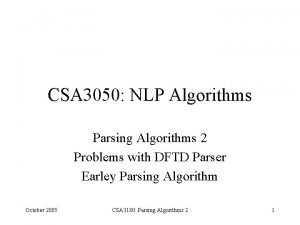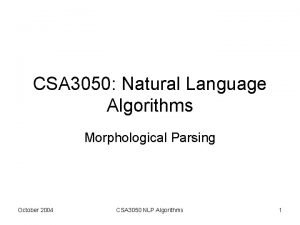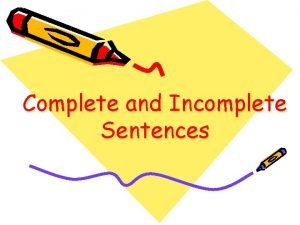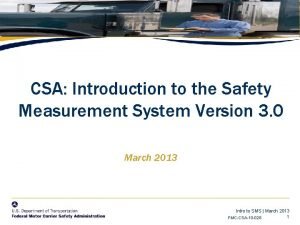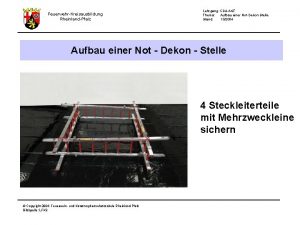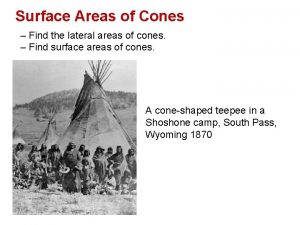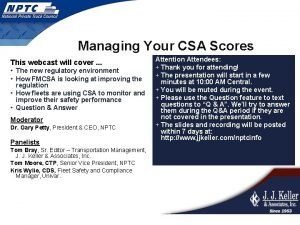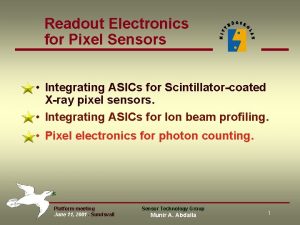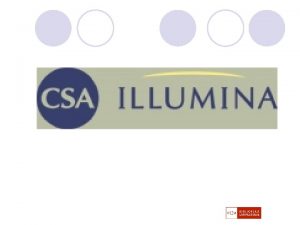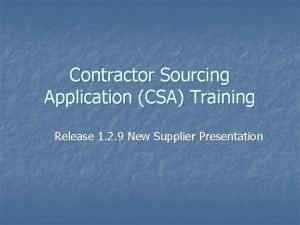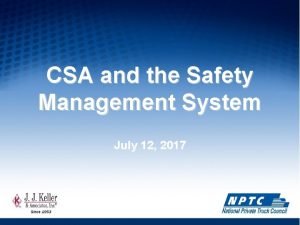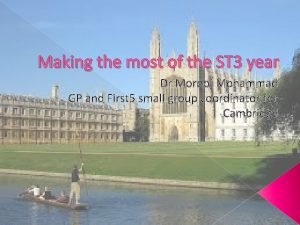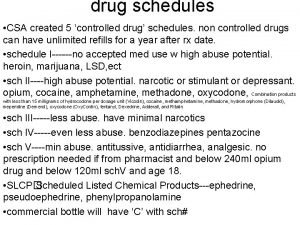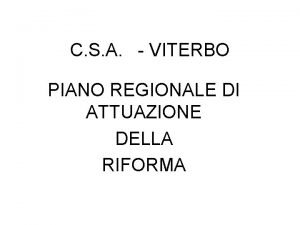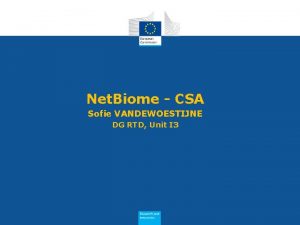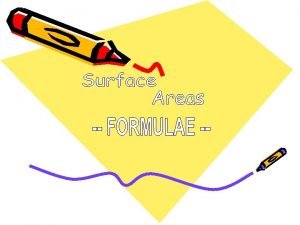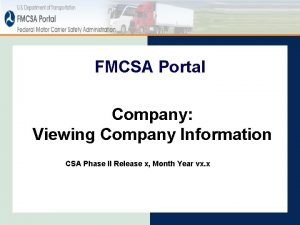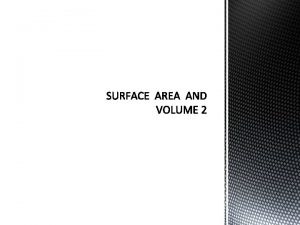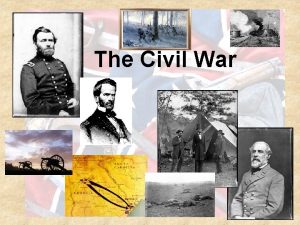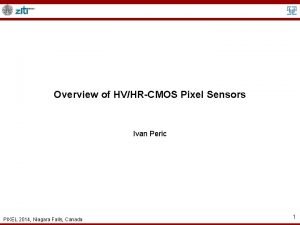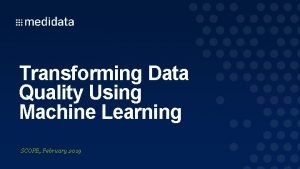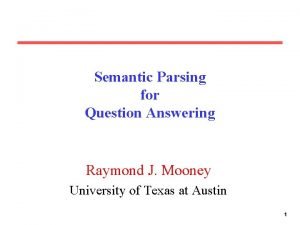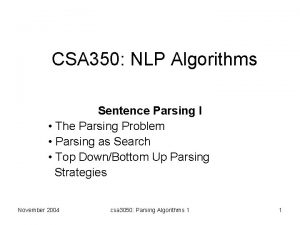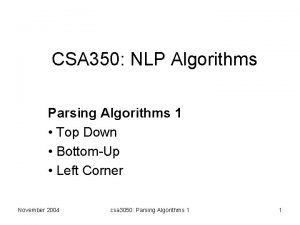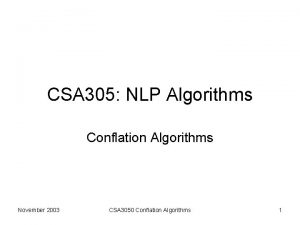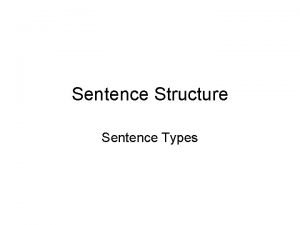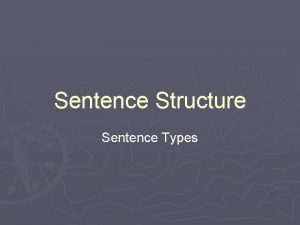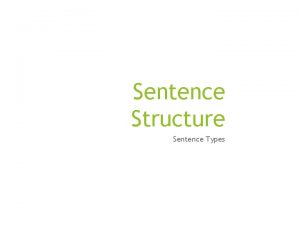CSA 350 NLP Algorithms Sentence Parsing I The






















![Recoding the Grammar/Lexicon % Grammar rule(s, [np, vp]). rule(np, [d, n]). rule(vp, [v, np]). Recoding the Grammar/Lexicon % Grammar rule(s, [np, vp]). rule(np, [d, n]). rule(vp, [v, np]).](https://slidetodoc.com/presentation_image_h2/8e24aa91c835c90f162d170bb9962dc4/image-23.jpg)
![Top Down Depth First Recognition in Prolog parse(C, [Word|S], S) : word(C, Word). parse(C, Top Down Depth First Recognition in Prolog parse(C, [Word|S], S) : word(C, Word). parse(C,](https://slidetodoc.com/presentation_image_h2/8e24aa91c835c90f162d170bb9962dc4/image-24.jpg)



![Shift/Reduce Implementation parse(S, Res) : sr(S, [], Res). sr(S, Stk, Res) : shift(Stk, S, Shift/Reduce Implementation parse(S, Res) : sr(S, [], Res). sr(S, Stk, Res) : shift(Stk, S,](https://slidetodoc.com/presentation_image_h2/8e24aa91c835c90f162d170bb9962dc4/image-28.jpg)



- Slides: 31

CSA 350: NLP Algorithms Sentence Parsing I • The Parsing Problem • Parsing as Search • Top Down/Bottom Up Parsing Strategies October 2008 csa 3180: Setence Parsing Algorithms 1 1

References • This lecture is largely based on material found in Jurafsky & Martin chapter 13 October 2008 csa 3180: Setence Parsing Algorithms 1 2

Handling Sentences • Sentence boundary detection. • Finite state techniques are fine for certain kinds of analysis: – named entity recognition – NP chunking • But FS techniques are of limited use when trying to compute grammatical relationships between parts of sentences. • We need these to get at meanings. October 2008 csa 3180: Setence Parsing Algorithms 1 3

Grammatical Relationships: e. g. subject Wikipaedia definition: The subject has the grammatical function in a sentence of relating its constituent (a noun phrase) by means of the verb to any other elements present in the sentence, i. e. objects, complements and adverbials. October 2008 csa 3180: Setence Parsing Algorithms 1 4

Grammatical Relationships: e. g. subject • The dictionary helps me find words. • Ice cream appeared on the table. • The man that is sitting over there told me that he just bought a ticket to Tahiti. • Nothing else is good enough. • That nothing else is good enough shouldn't come as a surprise. • To eat six different kinds of vegetables a day is healthy. October 2008 csa 3180: Setence Parsing Algorithms 1 5

Why not use FS techniques for describing NL sentences • Descriptive Adequacy – Some NL phenomena cannot be described within FS framework. – example: central embedding • Notational Efficiency – The notation does not facilitate 'factoring out' the similarities. – To describe sentences of the form subject-verb-object using a FSA, we must describe possible subjects and objects, even though almost all phrases that can appear as one can equally appear as the other. October 2008 csa 3180: Setence Parsing Algorithms 1 6

Central Embedding • The following sentences – The cat spat 1 1 – The cat the boy saw spat 1 2 2 1 – The cat the boy the girl liked saw spat 1 2 3 3 2 1 • Require at least a grammar of the form S → A n Bn October 2008 csa 3180: Setence Parsing Algorithms 1 7

DCG-style Grammar/Lexicon s s s np nom nom pp np vp vp % GRAMMAR --> np, vp. --> aux, np, vp. --> det nom. --> noun, nom. --> nom, pp --> prep, np. --> pn. --> v np October 2008 % LEXICON d --> [that]; [this]; [a]. n --> [book]; [flight]; [meal]; [money]. v --> [book]; [include]; [prefer]. aux --> [does]. prep --> [from]; [to]; [on]. pn --> [‘Houston’]; [‘TWA’]. csa 3180: Setence Parsing Algorithms 1 8

Definite Clause Grammars • Prolog Based • LHS --> RHS 1, RHS 2, . . . , {code}. • s(s(NP, VP)) --> np(NP), vp(VP), {mk-subj(NP)} • Rules are translated into executable Prolog program. • No clear distinction between rules for grammar and lexicon. October 2008 csa 3180: Setence Parsing Algorithms 1 9

Parsing Problem • Given grammar G and sentence A discover all valid parse trees for G that exactly cover A S VP NP V book Det that October 2008 csa 3180: Setence Parsing Algorithms 1 Nom N flight 10

The elephant is in the trousers S VP NP NP NP I shot October 2008 an elephant PP in csa 3180: Setence Parsing Algorithms 1 my trousers 11

I was wearing the trousers S VP NP NP I shot October 2008 an elephant PP in csa 3180: Setence Parsing Algorithms 1 my trousers 12

Parsing as Search • Search within a space defined by – Start State – Goal State – State to state transformations • Two distinct parsing strategies: – Top down – Bottom up • Different parsing strategy, different state space, different problem. • N. B. Parsing strategy ≠ search strategy October 2008 csa 3180: Setence Parsing Algorithms 1 13

Top Down • Each state comprises: – a tree – an open node – an input pointer • Together these encode the current state of the parse. • Top down parser tries to build from the root node S down to the leaves by replacing nodes with non-terminal labels with RHS of corresponding grammar rules. • Nodes with pre-terminal (word class) labels are compared to input words. October 2008 csa 3180: Setence Parsing Algorithms 1 14

Top Down Search Space Start node → Goal node ↓ October 2008 csa 3180: Setence Parsing Algorithms 1 15

Bottom Up • Each state is a forest of trees. • Start node is a forest of nodes labelled with pre-terminal categories (word classes derived from lexicon) • Transformations look for places where RHS of rules can fit. • Any such place is replaced with a node labelled with LHS of rule. October 2008 csa 3180: Setence Parsing Algorithms 1 16

Bottom Up Search Space failed BU derivation fl fl fl October 2008 csa 3180: Setence Parsing Algorithms 1 fl fl 17

Top Down vs Bottom Up Search Spaces • Top down • Bottom up – For: space excludes trees that cannot be derived from S – Against: space includes trees that are not consistent with the input October 2008 – For: space excludes states containing trees that cannot lead to input text segments. – Against: space includes states containing subtrees that can never lead to an S node. csa 3180: Setence Parsing Algorithms 1 18

Top Down Parsing - Remarks • Top-down parsers do well if there is useful grammar driven control: search can be directed by the grammar. • Not too many different rules for the same category • Not too much distance between non terminal and terminal categories. • Top-down is unsuitable for rewriting parts of speech (preterminals) with words (terminals). In practice that is always done bottom-up as lexical lookup. October 2008 csa 3180: Setence Parsing Algorithms 1 19

Bottom Up Parsing - Remarks • It is data-directed: it attempts to parse the words that are there. • Does well, e. g. for lexical lookup. • Does badly if there are many rules with similar RHS categories. • Inefficient when there is great lexical ambiguity (grammar driven control might help here) • Empty categories: termination problem unless rewriting of empty constituents is somehow restricted (but then it’s generally incomplete) October 2008 csa 3180: Setence Parsing Algorithms 1 20

Basic Parsing Algorithms • Top Down • Bottom Up • see Jurafsky & Martin Ch. 10 October 2008 csa 3180: Setence Parsing Algorithms 1 21

Top Down Algorithm 22
![Recoding the GrammarLexicon Grammar rules np vp rulenp d n rulevp v np Recoding the Grammar/Lexicon % Grammar rule(s, [np, vp]). rule(np, [d, n]). rule(vp, [v, np]).](https://slidetodoc.com/presentation_image_h2/8e24aa91c835c90f162d170bb9962dc4/image-23.jpg)
Recoding the Grammar/Lexicon % Grammar rule(s, [np, vp]). rule(np, [d, n]). rule(vp, [v, np]). October 2008 % Lexicon word(d, the). word(n, dog). word(n, cat). word(n, dogs). word(n, cats). word(v, chases). csa 3180: Setence Parsing Algorithms 1 23
![Top Down Depth First Recognition in Prolog parseC WordS S wordC Word parseC Top Down Depth First Recognition in Prolog parse(C, [Word|S], S) : word(C, Word). parse(C,](https://slidetodoc.com/presentation_image_h2/8e24aa91c835c90f162d170bb9962dc4/image-24.jpg)
Top Down Depth First Recognition in Prolog parse(C, [Word|S], S) : word(C, Word). parse(C, S 1, S) : rule(C, Cs), parse_list(Cs, S 1, S). % word(noun, cat). % rule(s, [np, vp]) parse_list([], S, S). parse_list([C|Cs], S 1, S) : parse(C, S 1, S 2), parse_list(Cs, S 2, S). October 2008 csa 3180: Setence Parsing Algorithms 1 24

Derivation top down, left-toright, depth first October 2006 25

Bottom Up Shift/Reduce Algorithm • Two data structures – input string – stack • Repeat until input is exhausted – Shift word to stack – Reduce stack using grammar and lexicon until no further reductions are possible • Unlike top down, algorithm does not require category to be specified in advance. It simply finds all possible trees. October 2008 csa 3180: Setence Parsing Algorithms 1 26

Shift/Reduce Operation Step 0 1 2 3 4 5 6 7 8 9 October 2008 Action (start) shift reduce reduce →| Stack the d dog d nd np barked np vp np s csa 3180: Setence Parsing Algorithms 1 Input the dog barked barked 27
![ShiftReduce Implementation parseS Res srS Res srS Stk Res shiftStk S Shift/Reduce Implementation parse(S, Res) : sr(S, [], Res). sr(S, Stk, Res) : shift(Stk, S,](https://slidetodoc.com/presentation_image_h2/8e24aa91c835c90f162d170bb9962dc4/image-28.jpg)
Shift/Reduce Implementation parse(S, Res) : sr(S, [], Res). sr(S, Stk, Res) : shift(Stk, S, New. Stk, S 1), reduce(New. Stk, Red. Stk), sr(S 1, Red. Stk, Res). sr([], Res). shift(X, [H|Y], [H|X], Y). ↑ ↑ stack sent nstack nsent October 2008 reduce(Stk, Red. Stk) : brule(Stk, Stk 2), reduce(Stk 2, Red. Stk). reduce(Stk, Stk). %grammar brule([vp, np|X], [s|X]). brule([n, d|X], [np|X]). brule([np, v|X], [vp|X]). brule([v|X], [vp|X]). %interface to lexicon brule([Word|X], [C|X]) : word(C, Word). csa 3180: Setence Parsing Algorithms 1 28

Shift/Reduce Operation • Words are shifted to the beginning of the stack, which ends up in reverse order. • The reduce step is simplified if we also store the rules backward, so that the rule s → np vp is stored as the fact brule([vp, np|X], [s|X]). • The term [a, b|X] matches any list whose first and second elements are a and b respectively. • The first argument directly matches the stack to which this rule applies • The second argument is what the stack becomes after reduction. October 2008 csa 3180: Setence Parsing Algorithms 1 29

Shift Reduce Parser • Standard implementations do not perform backtracking (e. g. NLTK) • Only one result is returned even when sentence is ambiguous. • May not fail even when sentence is grammatical • Shift/Reduce conflict • Reduce/Reduce conflict October 2008 csa 3180: Setence Parsing Algorithms 1 30

Handling Conflicts • Shift-reduce parsers may employ policies for resolving such conflicts, e. g. • For Shift/Reduce Conflicts – Prefer shift – Prefer reduce • For Reduce/Reduce Conflicts – Choose reduction which removes most elements from the stack October 2008 csa 3180: Setence Parsing Algorithms 1 31
 Parsing algorithms in nlp
Parsing algorithms in nlp Morphological parsing in nlp
Morphological parsing in nlp Top down parsing in nlp
Top down parsing in nlp Which of the supporting details or sentences is irrelevant?
Which of the supporting details or sentences is irrelevant? Incomplete sentence examples
Incomplete sentence examples Csa basic thresholds
Csa basic thresholds Csa feuerwehr
Csa feuerwehr Oblique cone surface area formula
Oblique cone surface area formula Csa basic thresholds
Csa basic thresholds Csa tracking system
Csa tracking system Ap computer science recursion multiple choice
Ap computer science recursion multiple choice Csa
Csa Ria ia csa
Ria ia csa Technology
Technology Rds.csa
Rds.csa Www.csa
Www.csa Contractor sourcing application
Contractor sourcing application How many basics are scored under csa
How many basics are scored under csa Bradford vts cbd
Bradford vts cbd Schedule 5 drugs
Schedule 5 drugs Csa notorious nine 2021
Csa notorious nine 2021 Provveditorato viterbo
Provveditorato viterbo Csacash
Csacash Dg csa
Dg csa Csa cube
Csa cube Fmcsa iss score
Fmcsa iss score Volume of frustum of cone
Volume of frustum of cone Csa vs usa
Csa vs usa Csa tw75
Csa tw75 Medidata csa
Medidata csa Ap csa
Ap csa Semantic parsing
Semantic parsing
